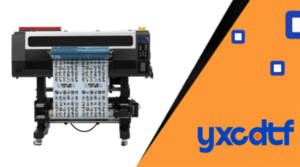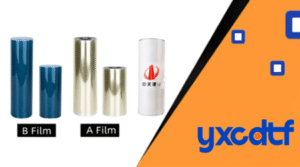This article delivers a comprehensive comparison of UV DTF (Ultraviolet Direct-to-Film) and DTF Textile (Textile Direct-to-Film) — two digital transfer technologies often confused due to their similar names but vastly different in applications, materials, equipment, and market impact. Whether you’re customizing clothing, hard goods, or promotional items, understanding the differences is crucial for making the right investment in equipment and materials. This guide is built for B2B buyers, helping them avoid costly mistakes and maximize ROI in their printing business.
1.Why Compare These Two DTF Methods?
As digital transfer printing evolves, two major trends have emerged: DTF for textiles and UV DTF for hard goods. Despite both being categorized under “DTF” (Direct-to-Film), these technologies serve completely different markets and use entirely different equipment and materials.
Understanding the differences between UV DTF and DTF Textile isn’t just technical knowledge — it’s essential for making strategic decisions about:
-
Equipment purchase
-
Material sourcing
-
Market targeting
-
Product development
-
Production workflows
✅ Fact Check: Industry surveys show that over 60% of new B2B buyers initially misunderstand the application scope of UV DTF vs DTF textile printing — often leading to costly returns or mismatched applications.
2.What Is DTF Textile Printing?
DTF Textile refers to a heat-based transfer printing technology used to apply custom designs to soft materials like fabric using pigment ink, hot melt adhesive powder, and heat pressing.
📌 Professional Definition:
DTF Textile Printing is a digital heat transfer process where water-based pigment inks are printed onto PET film. After applying a hot melt adhesive powder and curing, the design is heat-pressed onto various fabric types, resulting in vibrant, stretchable, and wash-resistant graphics. It is ideal for cotton, polyester, and blended garments.
🔬 Technical Highlights:
| Attribute | Description |
|---|---|
| Ink Type | Pigment-based CMYK + White |
| Media | DTF PET Film (Cold Peel) |
| Adhesion Process | Heat-activated powder glue |
| Application Surface | Textiles (T-shirts, hoodies, bags, etc.) |
| Finishing | Soft touch, flexible, washable |
✅ Pro Summary: DTF Textile is purpose-built for garment decoration, offering high-quality full-color transfers with good stretchability and excellent wash durability — up to 50 wash cycles under ISO 6330 testing.
🔗 Internal Link Suggestion: Check YXCDTF’s DTF Film & Ink Products
3. What Is UV DTF Printing?
UV DTF is a newer technology designed for hard, smooth, non-porous surfaces. It uses UV-curable inks that are instantly solidified via UV light, and then applied using a double-layer film system with pressure-sensitive adhesive.
📌 Professional Definition:
UV DTF Printing is a cold transfer printing method where UV inks (CMYK + white + varnish) are digitally printed onto a transparent A film. A laminating B film is applied to create a peel-and-stick transfer. The design can then be applied to hard surfaces without any heat, making it ideal for curved, non-fabric items like glass, metal, plastic, and ceramics.
🔬 Technical Highlights:
| Attribute | Description |
|---|---|
| Ink Type | UV-curable ink (CMYK + White + Varnish) |
| Media | UV DTF A/B Film System |
| Adhesion Process | Pressure-sensitive adhesive + UV curing |
| Application Surface | Hard surfaces (glass, acrylic, metal, ceramic) |
| Finishing | Glossy, waterproof, scratch-resistant |
✅ Pro Summary: UV DTF enables stunning, durable designs on non-fabric items without heat or complex equipment. It’s highly efficient for small batches, product customization, and promotional branding.
🔗 Internal Link Suggestion: Explore UV DTF Systems at YXCDTF
4. Core Differences: UV DTF vs DTF Textile
Here are the primary differentiators between these two technologies:
| Factor | DTF Textile | UV DTF |
|---|---|---|
| Material Compatibility | Cotton, Polyester, Blends (Soft) | Glass, Plastic, Metal, Ceramic (Hard) |
| Ink Type | Water-based Pigment Ink | UV-curable Ink |
| Transfer Method | Heat Press + Hot Melt Powder | Cold Peel + Lamination |
| Production Equipment | DTF Printer + Curing Oven + Press | UV DTF Printer + Laminator |
| Surface Flexibility | Flexible | Rigid |
| End Use Cases | Garments, Apparel | Bottles, Mugs, Gifts, Signs |
| Durability Factors | Wash-resistant | Scratch & Water Resistant |
✅ Fact Check: UV DTF cannot be used on textiles — the ink lacks the elasticity required for fabrics and will crack or peel upon flexing or washing.
Side-by-Side Feature Comparison Table
| Feature | DTF Textile | UV DTF |
|---|---|---|
| Application Surface | Fabric | Hard surfaces |
| Ink Compatibility | Pigment Ink | UV Ink |
| Adhesive Mechanism | Heat-activated powder | Pressure-sensitive adhesive |
| Requires Heat Press | ✅ Yes | ❌ No |
| Lamination Required | ❌ No | ✅ Yes |
| Washability | Excellent (50+ washes) | Not washable on fabric |
| UV Resistance | Moderate | High |
| Finishing Texture | Soft, breathable | Glossy, embossed |
| Production Speed | Medium | Fast |
| Cost per Unit (avg.) | Lower | Medium |
📊 Use this table for buyers to choose the right product based on surface, budget, and end-use.
5. Applications: What Can You Print With Each?
👕 DTF Textile Applications:
-
T-shirt printing (bulk or POD)
-
Fashion logo heat transfer
-
Workwear branding
-
Hat and bag decoration
-
Custom uniforms and merch
🪵 UV DTF Applications:
-
Acrylic keychains & badges
-
Tumblers, mugs, and drinkware
-
Glass jars and bottles
-
Phone cases and plastic toys
-
Wood signs and metal tags
✅ Pro Tip: If your product needs to flex, stretch or be washed, DTF Textile is the way to go.
For all other rigid, waterproof applications, UV DTF leads the game.
6. Cost Breakdown: Equipment, Ink & Production
| Category | DTF Textile | UV DTF |
|---|---|---|
| Printer Setup | $3,000 – $6,000 | $4,000 – $8,000 |
| Ink Cost (Per Liter) | $40 – $60 | $70 – $90 |
| Film Cost (Per Sq. Meter) | $0.80 – $1.20 | $1.00 – $1.50 |
| Maintenance Level | Low to Moderate | Moderate |
| Training Complexity | Easy | Medium |
| ROI Timeline | 3-6 months | 4-8 months |
✅ Fact Check: While UV DTF costs slightly more upfront, it enables value-added pricing for customized premium items — often yielding higher margins per piece.
7. Pros & Cons of Each Technology
✅ DTF Textile
Pros:
-
Excellent for all types of fabric
-
Stretchable, soft-touch finish
-
Affordable for mass garment production
-
Great color fidelity
Cons:
-
Not suitable for hard items
-
Requires curing and heat pressing
-
Slight color fade after extensive washing
✅ UV DTF
Pros:
-
Works on almost any rigid material
-
Vivid colors, glossy finish
-
Waterproof and scratch-resistant
-
Quick turnaround, no heat press
Cons:
-
Not applicable to fabric or flexible surfaces
-
Slightly higher setup costs
-
Lamination step adds complexity
8. Expert Business Scenarios: Which One Should You Choose?
| Business Type | Recommended Tech |
|---|---|
| T-shirt and hoodie factory | DTF Textile |
| Acrylic keychain wholesaler | UV DTF |
| Drinkware OEM manufacturer | UV DTF |
| Sportswear brand | DTF Textile |
| Custom product POD eCommerce | Both (Hybrid setup) |
| Promotional gifts supplier | UV DTF |
🧠 Expert Insight: Many businesses today run both DTF systems in parallel — one for textile production and one for hard goods, ensuring full product coverage for their customers.
9. Conclusion & Supplier Recommendation
DTF Textile and UV DTF are not competitors — they are complements. Understanding their differences enables businesses to:
-
Target the right customers
-
Avoid costly misapplications
-
Maximize ROI through surface-appropriate printing
✅ If you’re in apparel, fashion, or uniforms, DTF Textile is your go-to.
✅ If you focus on personalized gifts, packaging, or promotional merchandise, UV DTF is the superior choice.
🔧 Choose YXCHTV for Your DTF & UV DTF Needs
At YXCDTF, we provide end-to-end solutions for both DTF Textile and UV DTF, including:
-
High-resolution printers
-
Reliable PET films & consumables
-
OEM support and global logistics
-
Free samples and technical training
📩 Contact Us Today: https://www.yxcdtf.com/contact-us/
📦 Browse Products: DTF & UV DTF Catalog
💬 Let’s help you grow your business with better printing solutions — professionally, profitably, and globally.


